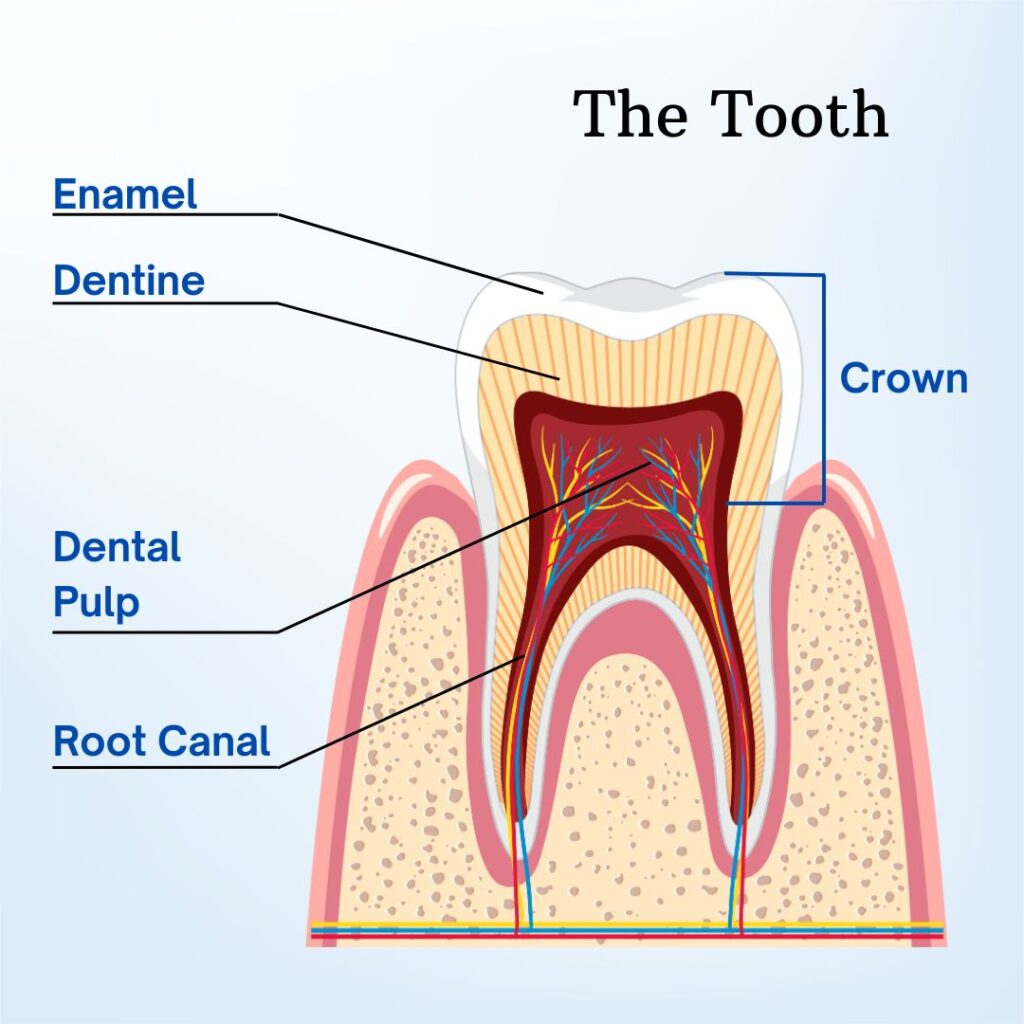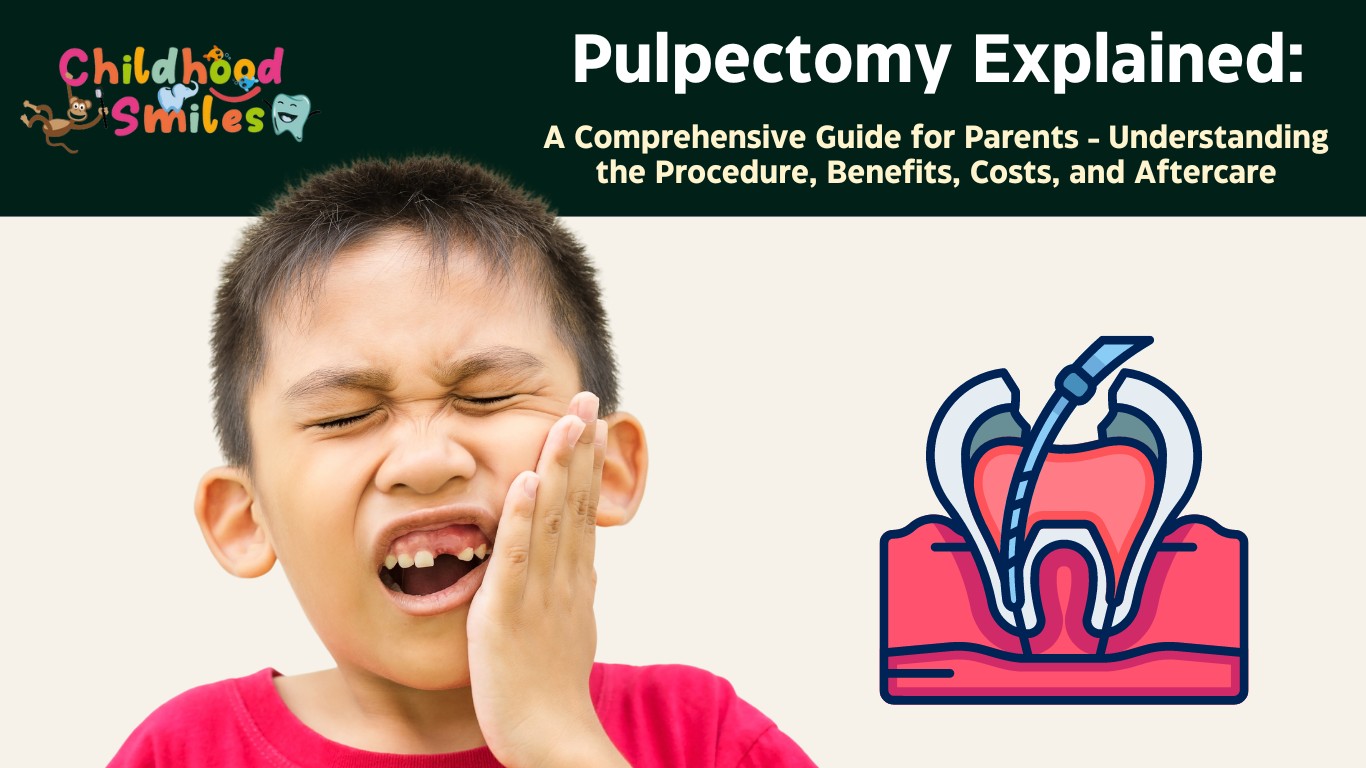Pulpectomy Explained: A Comprehensive Guide for Parents – Understanding the Procedure, Benefits, Costs, and Aftercare.
Tooth decay is one of the most common dental issues in children, often requiring a PULPECTOMY (Dental Treatment) if not addressed at the very beginning. As a pediatric dental clinic, we have seen parents being concerned about the procedure and having multiple questions regarding its necessity. This blog aims to answer those queries. We will cover what a pulpectomy is, why your child may need it, the procedure involved, associated costs, aftercare, and tips to prevent it. We will also cover the most commonly asked questions by parents about their child’s pulpectomy procedure.
Understanding Pulpectomy
What is Pulpectomy?
Pulpectomy is a pulp therapy for primary (milk) teeth and immature permanent teeth in children. This procedure is commonly performed to treat severe tooth decay or infection that has reached the pulp of the tooth.
What is Dental Pulp?
The pulp is the innermost part of the tooth, containing nerves and blood vessels. When infected, it can cause significant pain and discomfort.
The aim of this Pulpectomy Treatment is to remove the infected pulp, disinfect the tooth, and then fill and seal the tooth to prevent any further infection. Our pediatric dentist (a specialist in treating children’s dental problems) typically recommends this procedure when the tooth infection is too severe to be treated with a simple filling.

Often, Parents Ask: Can’t we just extract (pull) the tooth out since it is a milk tooth and will eventually fall off anyway?
It’s true that milk teeth will fall out eventually, but if we pull them before they fall out naturally, it can impact the development and alignment of the upcoming permanent teeth. Early loss of baby teeth can cause:
- Misalignment of Permanent Teeth
- Speech Development Issues
- Chewing and Eating Problems
- Impact on Jaw Growth
Pulpectomy vs. Root Canal
A pulpectomy is primarily performed on children, focusing on removing the infected pulp from primary (baby) teeth or immature permanent teeth while preserving the tooth’s structure and function.
In contrast, a root canal treatment is typically performed on adults with mature permanent teeth. This procedure also involves removing the infected pulp, but it often includes more extensive cleaning and shaping of the root canals before filling and sealing them.
Both treatments aim to save the tooth and alleviate pain, but pulpectomy is specifically designed for the unique dental anatomy and developmental needs of children, while root canal treatment addresses the complexities of adult teeth.
Pulpectomy vs. Pulpotomy
A pulpotomy is a less invasive procedure that involves removing only the diseased portion of the tooth’s pulp from the crown, leaving the healthy pulp in the root canals intact. This treatment is typically used when the infection has not spread beyond the crown of the tooth.
On the other hand, a pulpectomy is more comprehensive, involving the complete removal of the infected pulp from both the crown and the root canals. This procedure is necessary when the infection has extended deeper into the tooth, affecting the entire pulp.
Both treatments aim to alleviate pain, eliminate infection, and preserve the natural tooth, but the choice between the two depends on the severity of the decay and the extent of the infection.
Often, Parents Ask: Why can’t we just fill the tooth instead of doing a pulpectomy?
A filling can help if the decay is superficial, but when the decay reaches the inner portion of the tooth and infects or damages the pulp, the pulp needs to be removed to prevent further infection, pain, or abscess formation. A filling only seals the outer surface of the tooth, whereas in a pulpectomy, we clean the infected pulp, disinfect the area, and then fill and seal the tooth.
If a pulpectomy is not done, an abscess can form, and the infection can spread beyond the tooth to the jawbone. This spread of infection can also affect the development of the permanent teeth.
Pulpectomy vs. Extraction
It’s just a baby tooth, wouldn’t it be better to pull it out?
This is a question we hear often from parents. While it might seem like an easy solution, it can actually lead to multiple dental problems.
Baby teeth serve as placeholders for permanent teeth, guiding them into the correct position. Pulling out a baby tooth prematurely can lead to misalignment, spacing issues, and even problems with speech and chewing. On the other hand, a pulpectomy allows the tooth to remain in place until it naturally falls out, ensuring that the permanent teeth have the proper space to develop correctly. This helps maintain proper dental alignment and overall oral health.
Situations where extraction might be a better option than pulpectomy
- If the tooth is severely decayed or damaged to the point where it cannot be restored, extraction may be the only viable option.
- If the infection has spread beyond the tooth into the surrounding bone or soft tissues and there is a significant risk that the infection could continue to spread, potentially leading to serious health issues.
- If the affected tooth is close to its natural time of shedding (when baby teeth fall out to make way for permanent teeth), extraction might be a simpler and more effective solution. A x-ray can help judge this situation.
Signs that Your Child Need Pulpectomy
- Persistent Tooth Pain: One of the most common signs that your child might need a pulpectomy is ongoing tooth pain. If your child complains of pain that doesn’t go away, particularly when eating, drinking, or even at rest, this could indicate that the tooth’s pulp is infected. This pain is often severe and can be throbbing or sharp, sometimes radiating to other parts of the mouth.
- Sensitivity to Hot or Cold Foods: Increased sensitivity to hot or cold foods and drinks is another red flag. If your child experiences discomfort that lingers long after consuming something hot or cold, it may suggest that the nerve inside the tooth is affected. This kind of sensitivity often indicates that the tooth decay has reached the pulp
- Swelling and Tenderness: Swelling around the affected tooth or in the surrounding gums can be a sign of a deep infection. The area might feel tender to the touch, and the swelling could spread to the face or jaw if the infection is severe.
- Tooth Discoloration: A tooth that turns dark or grayish in color may be a sign of pulp damage. This discoloration happens because the pulp inside the tooth is dying or dead, often due to trauma or severe decay.
- Gum Infection or Abscess: An abscess or a pimple-like bump on the gums near the affected tooth is a clear indication of a serious infection. This abscess may be filled with pus and can cause a foul taste in your child’s mouth. If left untreated, the infection can spread to other areas of the mouth and even lead to more severe health problems.
- Complaints of Tooth Discomfort, Fever and Malaise: In some cases, a dental infection requiring a pulpectomy can lead to systemic symptoms like fever, fatigue, or general malaise. These symptoms occur when the body is fighting off the infection and should not be ignored.
The Pulpectomy Procedure
Understanding the steps involved in a pulpectomy can help ease any concerns or anxiety about the procedure.
Here’s what you can expect:
a. Initial Examination: Our pediatric dentist will begin with a thorough examination of the affected tooth, often using X-rays to assess the extent of the infection and to plan the procedure.
b. Anesthesia and/or Sedation: To ensure the child is comfortable and pain-free, a local anesthetic is applied to numb the area around the affected tooth. In some cases, sedation may be used for very anxious children.
c. Pulp Removal: Once the tooth is numb, the pediatric dentist will create a small opening in the tooth’s crown to access the infected pulp. All the diseased pulp tissue is carefully removed from both the crown and the root canals.
d. Filling the Canal: After removing the pulp, the pediatric dentist cleans and disinfects the empty canals to eliminate any remaining bacteria. The canals are then filled with a biocompatible material which helps maintain the tooth’s integrity until it naturally falls out.
e. Sealing the Tooth: Finally, the tooth is sealed with a crown or a restorative material to protect it from further damage. This also restores the tooth’s function and appearance.
Often, Parents Ask: Is Pulpectomy Painful?
Pulpectomy is generally not painful, especially when performed by a skilled pediatric dentist.
Local Anesthesia: The pediatric dentist at childhood smiles will administer a local anesthetic to numb the affected tooth and surrounding area, ensuring that your child does not feel pain during the pulpectomy.
Sedation Options: For added comfort and to help ease anxiety, we offer sedation options such as laughing gas (nitrous oxide. Laughing gas helps your child feel relaxed and calm during the procedure.
Comfort Measures: Our pediatric dentist uses techniques and tools designed to minimize discomfort. Your child might feel some pressure or minor sensations, but the procedure itself should not be painful.
Post-Procedure Care and Precautions
Taking the right steps following the treatment can help your child avoid complications, reduce discomfort, and maintain overall oral health.
a. Managing Discomfort and Pain: It’s normal for your child to experience some discomfort or mild pain after a pulpectomy once the anesthesia wears off. Follow the medication provided by our pediatric dentist to help manage this discomfort.
b. Eating and Drinking: For the first few hours after the procedure, it’s best to stick to soft foods and liquids to avoid irritating the treated area. Your child should avoid biting heavy from the tooth until crown is placed.
c. Oral Hygiene: Maintaining good oral hygiene is crucial after a pulpectomy to prevent infection and ensure the treated tooth stays healthy. Your child should continue brushing their teeth twice a day with a soft-bristled toothbrush. However, they should be gentle around the treated tooth to avoid disturbing the area.
d. Monitoring: While complications after a pulpectomy are rare, it’s important to monitor your child for any signs of trouble. In case of any discomfort contact us immediately for further evaluation and treatment.
e. Follow-up Appointment: Follow-up visits with our pediatric dentist is essential to monitor the healing process and ensure the pulpectomy was successful.
f. Emotional Support: A pulpectomy can be a stressful experience for a child, so providing emotional support is just as important as physical care.
What to Do to Avoid Pulpectomy?
To avoid the need for a pulpectomy, proactive dental care is essential. Here are some key steps to help prevent tooth decay and its progression.
a. Maintain Good Oral Hygiene: Ensure your child brushes their teeth at least twice a day with fluoride toothpaste and flosses daily to remove food particles and plaque.
b. Regular Dental Check-ups: Schedule regular visits to the pediatric dentist for professional cleanings and check-ups. Early detection of dental decay can help managing it without pulpectomy.
c. Healthy Diet: Limit sugary snacks and beverages, which can contribute to tooth decay. Encourage a balanced diet rich in fruits, vegetables, and whole grains.
d. Preventive Treatments: Consider fluoride treatments if recommended by pediatric dentist to strengthen tooth enamel and protect against cavities. Additionally, Dental sealants can be applied to the chewing surfaces of back teeth to protect them from cavities, especially in children who are prone to tooth decay.
By following these preventive measures, you can help safeguard your child’s dental health and reduce the risk of conditions that might require a pulpectomy.

